Are you a newbie to the thrilling world of dirt biking? Welcome to the club! Dirt biking is an exhilarating sport that promises adrenaline-pumping adventures on two wheels. In this guide, we’re diving into the essentials of dirt bike setup for beginners.
From the ergonomics of your ride to choosing the right tires and adjusting your suspension, we’ve got you covered.
Whether you’re a teenager just getting started or someone looking to fulfill a lifelong dream, one thing is for sure: the right dirt bike setup can make all the difference in your off-road journey.
So let’s get into the world of dirt bike setup for beginners!
1. Ergonomics: Finding Your Perfect Fit
One of the first considerations for a beginner dirt bike setup is ergonomics. Getting comfortable on your bike is essential not only for comfort but also for control and safety. Here’s what you need to consider:
- Handlebar Rotation and Position: The handlebar rotation and position should allow you to stand comfortably while riding, without bending your back too much. Experiment with different handlebar bends or handlebars with varying heights to find your sweet spot.
- Lever and Grips: Comfortable lever position and choice of grips are crucial to having optimal control of your bike.
- Seat Height: Seat height can be a concern for riders of all experience levels, but it’s especially crucial for beginners. You should be able to just touch the ground with at least the ball of the foot on one side when seated, allowing you to stabilize the bike when needed. You don’t need to be able to touch the ground flat-footed on both sides.
Now, let’s delve into each aspect of dirt bike setup in more detail:
Handlebar Rotation and Position:
When you view your bike from the side (best done when it’s on the center stand) the line of the handlebar bend should be in line with the line of the fork legs. This will give you the standard rotation position.
Some bikes have a printed chart in the center of the handlebar. It has incremental lines for handlebar rotation. Rotating forward will help the bike turn more aggressively while rotating backward makes the bike feel more stable.
Most dirt bikes these days have four different mounting positions in the triple clamp giving you a forward and backward adjustment. Start in a middle position and make adjustments from there.
Levers and Grips:
After you have adjusted your handlebars, the next step is to find a comfortable lever position.
Proper lever adjustment can make a significant difference in how you operate your bike. Beginners should ensure that clutch and brake levers are within easy reach of their fingers without overextending. Most levers have adjustable reach settings, allowing you to customize them to fit your hand size and riding style.
The lever reach can be adjusted with a small screw at the base of the lever base. They can easily be adjusted for a suitable reach, depending on the size of your hands.
Lever rotation on the handlebars is also very important. Slightly downward below horizontal is generally the most comfortable. When seated on the bike, fingers in line with your arms in a straight position is generally the best.
Your grips may seem like a minor detail, but they play a crucial role in your comfort and control. Grips come in various materials, textures, and thicknesses.
Some riders prefer softer, more cushioned grips, while others opt for firmer options that provide better feedback. Experiment with different grip styles to see what feels best in your hands during long rides.
For a look at some of the most popular Dirt Bike grips: 10 Best Dirt Bike Grips – Comfort and Feel Is Vital
Seat Height:
Seat height is a common concern, especially for beginners who want to make sure they can touch the ground comfortably when coming to a stop. However, it’s important to strike a balance between having a low enough seat for stability and a high enough seat for ground clearance.
Ever since the introduction of long-travel suspension, dirt bikes have got taller to accommodate the suspension travel. If you are much shorter than about 5′ 8″, you will find a lot of bikes too tall for you. There are several things you can do to lower your seat height. These are covered below:
For tips on lowering your ride height: How To Lower A Dirt Bike Seat Height
This chart is a rough guide for rider height/seat height. It is a rough guide but a good starting point.
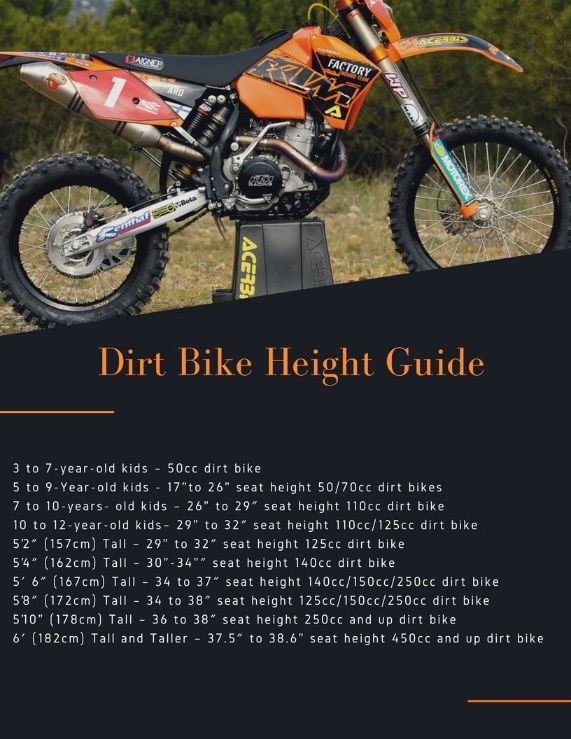
2. Suspension Adjustment: Smooth Out the Bumps
Your bike’s suspension plays a pivotal role in your riding experience. It absorbs the shocks and bumps that come your way, allowing you to maintain control even on rugged terrain.
These days, Dirt Bike suspension is infinitely more adjustable than it used to be back in the ’70s and ’80s. You can learn to set up your bike yourself for different terrain types.
Adjusting the compression and rebound damping, spring preload, and sag will make a big difference to your bike’s handling. It all sounds complicated, but you can learn how to do the basics in the link below.
Setting the sag of your rear shock is easily done in about 20 minutes even if you have no prior experience in maintenance. It’s basically a matter of taking some measurements at the back wheel with you in your full riding gear both sitting on the bike and off the bike. You will need the help of a friend to do this.
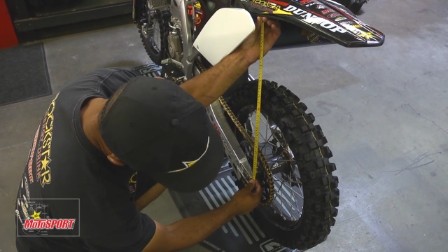
Most bikes call for a sag of about 4 inches (100-110mm). Check your owner’s manual for the number specific to your bike.
For tips on suspension adjustment: How To Adjust Your Dirt Bike Suspension – A Do It Yourself Guide
3. Choice of Tire Types: Get a Grip!
Tires are your connection to the ground, and choosing the right ones can significantly impact your ride. There are various tire types, including knobbies, trials, and hybrids, each designed for specific terrains and riding styles.
When it comes to dirt bike tires, there’s no one-size-fits-all solution. The type of tire you choose depends on the terrain you’ll be tackling and your riding style. Let’s explore some popular tire types and how they can impact your dirt bike setup.
1. Dunlop: The All-Terrain Performer
Dunlop has a solid reputation in the dirt biking community for producing high-quality tires suitable for various terrains. Their range includes options for motocross, enduro, and trail riding. If you’re unsure about the terrain you’ll encounter, Dunlop’s versatile tires are a safe bet.
2. Pirelli: Paving the Way to Excellence
Pirelli is another top choice for dirt bike tires. Their Scorpion MX series is well-regarded for its performance on motocross tracks, while the MT series offers excellent grip for off-road adventures. Pirelli’s dedication to innovation ensures you’ll find a tire that suits your needs.
3. Continental: Traction and Durability
Continental’s line of dirt bike tires is known for its impressive traction and durability. Whether you’re hitting the trails or exploring rocky terrain, Continental has options to keep you planted firmly on the ground. The Continental TKC tires have long been a favorite for heavy adventure bikes.
4. Michelin: A French Touch for Dirt Biking
Michelin is a global tire giant, and their presence extends to the dirt bike world as well. Their tires are known for providing consistent performance, and the StarCross 5 series is particularly popular among motocross enthusiasts.
5. Shinko: Affordable Off-Road Options
If you’re on a budget, Shinko offers affordable dirt bike tires without compromising quality. They cater to a wide range of riders and terrains, making them an excellent choice for beginners looking to get the most value for their money. Very popular for Dual Sport riders.
6. Kenda: Tires for Every Rider
Kenda offers a comprehensive lineup of dirt bike tires, making them a versatile choice. Whether you’re into motocross, desert racing, or trail riding, Kenda has a tire to suit your needs. Another brand that is very popular for Dual Sport Riders.
For a look at some of the best Dual Sport tires on the market: 5 Best Dirt Bike Tires For Dual Sport Riding
Now that you know about some of the top tire brands, it’s essential to consider the right tire pressure.
4. Tire Pressures
Proper tire pressure can significantly impact your bike’s performance and handling. For most dirt bikes, running a lower tire pressure (around 12-15 psi) enhances grip and traction on uneven terrain. Harder pressures reduce your traction but also reduce your chance of a flat tire. It’s a bit of a tradeoff.
It’s crucial to adjust the pressure based on your bike’s weight, your riding style, and the specific conditions you’ll be facing.
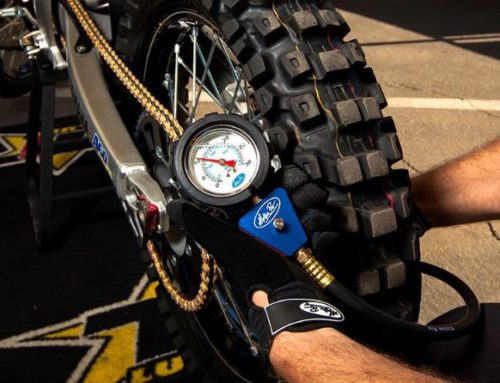
For a complete guide on setting your tire pressures: Dirt Bike Tire Pressure: What You Need To Know
5. Protection of Levers and Controls: Guarding Your Essentials
Dirt biking can be a bit rough, which means protecting your bike’s levers and controls is a smart move. You don’t want to find yourself stuck on the trail with a broken clutch lever.
Your bike’s levers and controls are vulnerable to damage, especially if you’re navigating challenging terrain. Here’s how you can protect these vital components and ensure they’re set up just right for your beginner dirt bike experience.
Handguards are an essential add-on to a dirt bike. There are two basic types, depending on the type of riding you do:
- The open MX type, usually preferred by motocross riders, offers not much more than roost protection
- The wrap-around Enduro/Trail riding type, which is fixed to the handlebar end and protects the levers from breaking in a fall
Here’s a look at some of the best, for both motocross and enduro/trail riders: 6 Best Dirt Bike Handguards – For MX & Enduro Riders
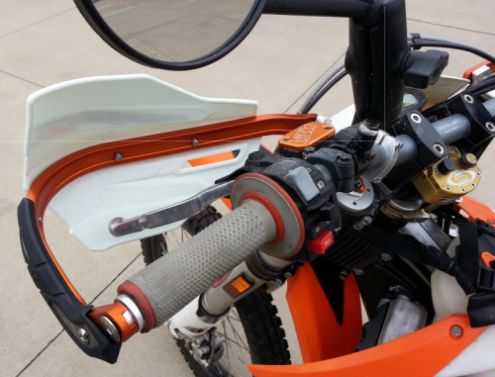
Protecting Other Vitals
Modern Dirt bikes are pretty well designed to take a beating off-road and come with the basic protection as standard from the factory. Some areas may need accessory equipment added.
Vulnerable areas to protect on your bike are:
Brake Discs: If your bike doesn’t come standard with brake disc protection, adding some aftermarket products is far cheaper than replacing bent discs. Generally, the front disc can be protected with a less expensive plastic front disc guard. It will also keep a lot of mud out of the brake pads.
The rear brake disc is better protected with a heavier-duty aluminum or steel disc guard.
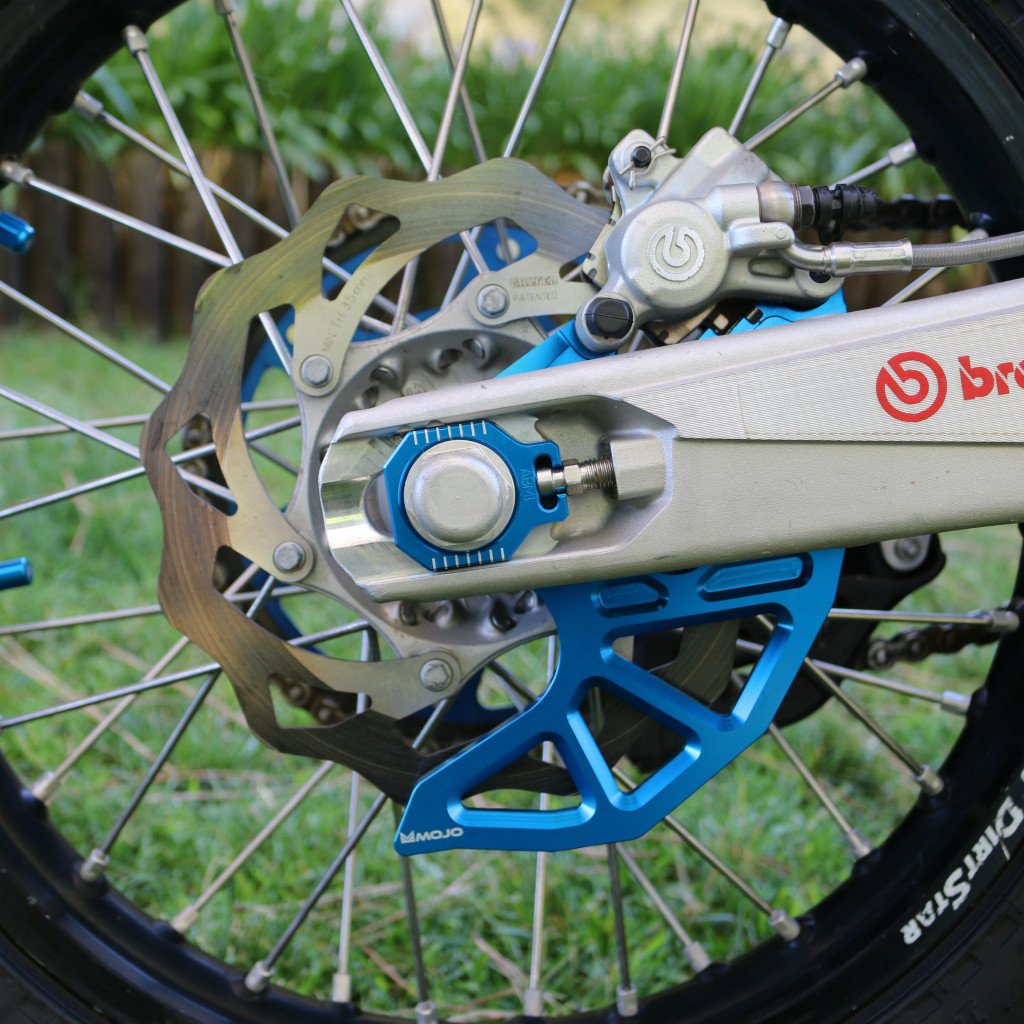
Engine and frame: A skid plate is essential to protect the engine cases and frame. If you ride a lot of rocky terrain or slide your bike over obstacles like logs, they can save you expensive repairs. Aluminum skid plates are slightly heavier than plastic ones but will take much harder hits.
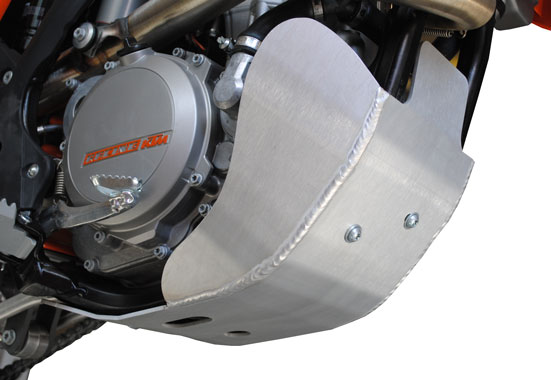
Exhaust Pipe: Pipe guards are a must for 2-strokes with a very vulnerable expansion chamber. It is in a much more prone position than the silencer for damage. Steel and aluminum are less expensive than carbon fiber and composite materials.
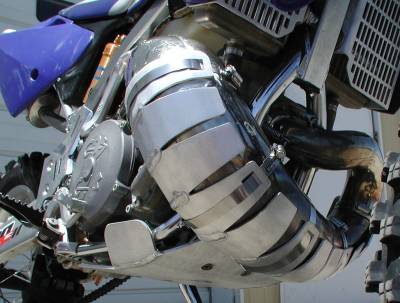
Sprockets: Most bikes come standard with a lower chain guide to protect the rear sprocket and prevent debris from derailing the chain. In addition, a front sprocket guard will stop the chain from getting stuck against the engine case and may save you from a cracked engine case in the event of a chain break.
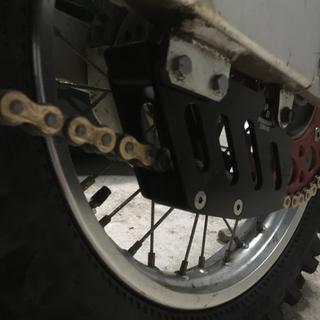
6. Gearing and Power Delivery
Engine Performance: The Heart of Your Ride
Now, let’s shift our focus to the powerhouse of your dirt bike: the engine. Engine performance can significantly impact your riding experience, and it’s important to understand how to optimize it for your needs.
Gearing and Power Delivery: Finding Your Ideal Ratio
Gearing is a crucial aspect of your dirt bike setup, as it directly affects how power is delivered to the wheels. The right gearing can enhance your bike’s performance for the type of riding you enjoy.
- Low Gearing: If you’re primarily riding in tight and technical trails, lower gearing with a smaller front sprocket and larger rear sprocket will give you better low-end torque and control. This setup helps you navigate obstacles and steep inclines with ease.
- High Gearing: For riders who prefer open tracks or desert riding, higher gearing with a larger front sprocket and smaller rear sprocket can help you achieve higher top speeds. It allows your bike to stretch its legs and cruise effortlessly.
Finding the ideal gearing setup is a matter of personal preference and the type of terrain you’ll be riding on. Many riders experiment with different sprocket combinations to strike the right balance between low-end power and top-end speed.
For a useful chart on motorcycle gear ratios: Motorcycle Sprocket Size/Ratio Calculator
You generally find with dirt bikes these days, that the standard gearing it comes with from the factory will be suitable for 99% of riders for their usual trail riding or enduro use. It’s good to understand the basics though.
7. Throttle and Power Modes: Taming the Beast
Some modern dirt bikes come equipped with multiple power modes or throttle mapping settings. These features allow you to adjust how the engine delivers power to the wheels.
- Beginner Mode: Many bikes have a beginner or softer power mode that reduces throttle response and tames the engine’s aggressiveness. This mode is ideal for newcomers who want a gentler introduction to dirt biking.
- Standard Mode: Standard mode provides a balanced power delivery suitable for a wide range of riding conditions.
- Aggressive Mode: For experienced riders seeking maximum power and responsiveness, an aggressive mode can unleash the full potential of the engine.
Bikes like the Yamaha WR250F and WR450F allow you to change the mapping to suit different riding conditions by WiFi using your smartphone. Simply download the Power Tuner app and it allows you to make fueling and ignition timing changes instantly and also upload and share them.
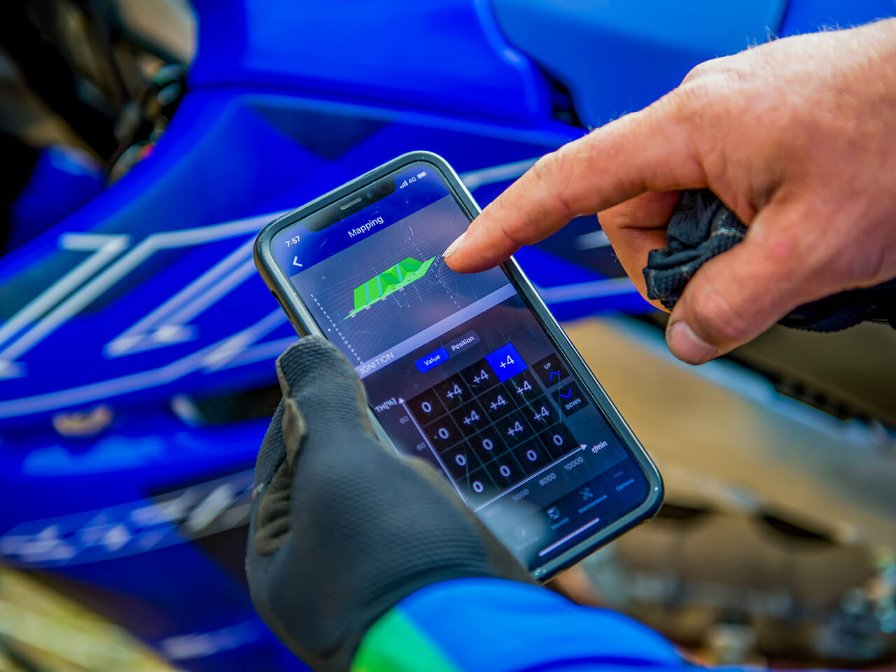
When starting out, it’s advisable for beginners to use the softer power modes until they gain confidence and experience.
Conclusion: Setting Yourself Up for Success
Congratulations! You’ve embarked on an exciting journey into the world of dirt biking, and now you’re armed with the knowledge to set up your bike for a thrilling and safe ride. Let’s recap the key takeaways:
- Ergonomics: Find the right handlebar position, lever position, grip choice, and seat height to ensure comfort and control on your bike.
- Suspension Adjustment: Tailor your bike’s suspension to your weight, riding style, and terrain to enjoy a smoother ride.
- Choice of Tires: Select the appropriate tire type based on the terrain you’ll encounter. Preferred brands like Dunlop, Pirelli, Continental, Michelin, Shinko, and Kenda offer a wide range of options.
- Tire Pressures: Adjust tire pressures according to your bike’s weight and the conditions you’ll face. Lower pressures can provide better grip on uneven surfaces. Harder pressures reduce your traction
- Protection of Levers and Controls: Safeguard your bike’s levers and controls, ensuring they’re within easy reach and protected from damage.
- Gearing and Power Delivery: Choose the right gearing setup to match your riding style and terrain. Remember that lower gearing provides more low-end torque, while higher gearing offers higher top speeds.
- Throttle and Power Modes: If your bike has multiple power modes, use them to adjust the engine’s responsiveness to your skill level.
As you embark on your dirt biking adventures, remember that setup is not a one-size-fits-all solution. It’s a personal journey that may require some trial and error to find what works best for you.
Lastly, always prioritize safety. Wear the appropriate protective gear, including a helmet, gloves, goggles, and suitable riding apparel. Take it slow at first, practice in controlled environments, and gradually build your skills.
Now, with your dirt bike set up for success, you’re ready to hit the trails, conquer new challenges, and experience the thrill of off-road riding to the fullest. Enjoy the ride and stay safe out there!
Related Posts
Tips For A Beginner Dirt Bike Rider
Dirt Bike Types – How To Choose The Right One For You
How To Buy A Used Dirt Bike – What To Look Out For
Are you just starting out in Dirt Bike riding? Please feel free to share any experiences below.

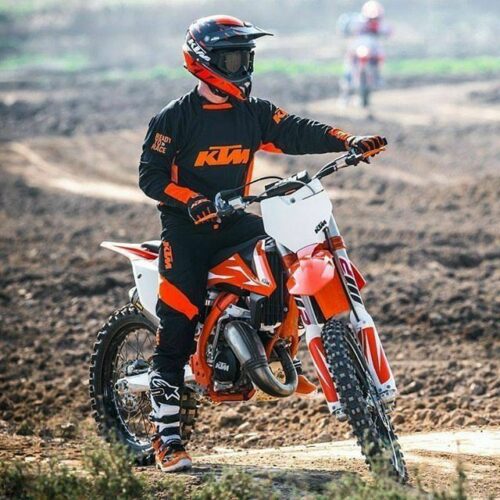
This guide is a fantastic starting point for anyone new to the dirt biking world! It provides a thorough breakdown of key setup elements, from ergonomics and suspension adjustments to tire choices and gearing. Each section is well-organized, making it easy for beginners to follow and apply.
Hi Alen. Glad you enjoyed it. There are tips on just about everything on this website. Thanks for your comments.
Greg
The breakdown of ergonomics, suspension, and tire choices is spot-on, and it makes the learning process feel much less intimidating.
There are so many things to consider. Starting with ergonomics and tires, then progress from there. Luckily bikes come pretty well setup from the factory, there’s always adjustment for a riders height and weight, and experience.
I especially appreciate the practical tips like adjusting handlebar rotation and seat height for better comfort and control.
Hi Alen. Yes, the simple stuff like handlebar and lever position is the first place to start. Then go on from there if needed.
It’s inspiring to see such a thorough resource for beginners, can’t wait to put these insights into practice!
Hi Hank. I write these posts with beginners in mind, and make it easy to follow. With over 40 years of riding experience, I have a lot to share.
If you are new to dirt biking, this handbook is a great place to start! Key setup components are thoroughly broken down, including tire selection, gearing, suspension changes, and ergonomics. Because of its organization, each section is simple for novices to understand and use.
Hi Hank. I write these posts with beginners in mind to make the setup easy to understand. There’s so much room for adjustment in modern bikes now.
A well-adjusted dirt bike setup is key for beginners, ensuring comfort, control, and a smoother off-road experience.
Hi Steven. Yes, getting the setup right is critical, especially the suspension. There is a post on my website about suspension setup you can do yourself.
Getting the right dirt bike setup is crucial for beginners, helping to enhance comfort, safety, and overall riding experience.
Hi Emily. Yes, getting the setup right makes for a more enjoyable ride. Bikes are so much more adjustable than when I started riding. Especially the suspension.
Nice Blog
Thanks for your comment. Dirt bikes have been my passion for over 40 years now. Still love it.
Tips For A Beginner Dirt Bike Rider